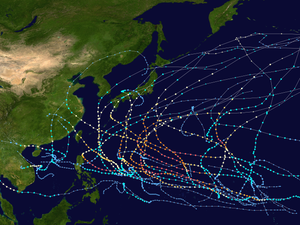
Back 1997年の台風 Japanese 1997년 태풍 Korean Tyfoonseizoen van de Grote Oceaan 1997 Dutch Temporada de tufões no Pacífico de 1997 Portuguese Mùa bão Tây Bắc Thái Bình Dương 1997 Vietnamese 1997年太平洋颱風季 Chinese
| 1997 Pacific typhoon season | |
|---|---|
 Season summary map | |
| Seasonal boundaries | |
| First system formed | January 19, 1997 |
| Last system dissipated | December 23, 1997 |
| Strongest storm | |
| Name | Ivan and Joan |
| • Maximum winds | 295 km/h (185 mph) (1-minute sustained) |
| • Lowest pressure | 905 hPa (mbar) |
| Seasonal statistics | |
| Total depressions | 47 |
| Total storms | 29 |
| Typhoons | 16 |
| Super typhoons | 11 (unofficial) (record high tied with 1965) |
| Total fatalities | 4,036 total |
| Total damage | > $4.977 billion (1997 USD) |
| Related articles | |
The 1997 Pacific typhoon season was a record-breaking season featuring 11 tropical cyclones reaching super typhoon intensity, tying the record with 1965 with the most violent tropical cyclones globally, and was the ninth and last consecutive year of above-average tropical cyclone activity that started in 1989. Its extremely high activity produced a total of 570 ACE index, which is the highest ever index recorded in a single tropical cyclone season. In addition, this season had 10 Saffir-Simpson Category 5-equivalent tropical cyclones, the most ever recorded, even greater than the 2005 Atlantic hurricane season, which had nearly half of the amount. The 1997–98 El Niño event was a contributing factor to this unusually high activity. Despite this, the season produced an average number of tropical storms, spawning 29 tropical storms.
It has no official bounds; it ran year-round in 1997, but most tropical cyclones tend to form in the northwestern Pacific Ocean between May and November.[1] These dates conventionally delimit the period of each year when most tropical cyclones form in the northwestern Pacific Ocean. The first named storm, Hannah, developed on January 20 while the last named storm, Paka, dissipated on December 23. Tropical Storm Linda became the worst tropical cyclone to hit Vietnam, killing over 3,000 people
The scope of this article is limited to the Pacific Ocean, north of the equator and west of the International Date Line. Storms that form east of the Date Line and north of the equator are called hurricanes; see 1997 Pacific hurricane season. Tropical Storms formed in the entire west Pacific basin were assigned a name by the Joint Typhoon Warning Center. Tropical depressions in this basin have the "W" suffix added to their number. Tropical depressions that enter or form in the Philippine area of responsibility are assigned a name by the Philippine Atmospheric, Geophysical and Astronomical Services Administration or PAGASA. This can often result in the same storm having two names.
- ^ Gary Padgett. May 2003 Tropical Cyclone Summary. Archived September 25, 2006, at the Wayback Machine Retrieved on 2006-08-26.
© MMXXIII Rich X Search. We shall prevail. All rights reserved. Rich X Search